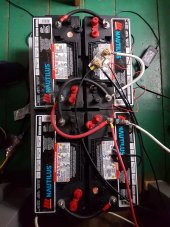I have an off-grid cabin. Last summer I installed 4x250watt panels, a 40amp mppt charge controller, 4x100 amp-hr batteries, and a 1500watt/3000 watt surge inverter. All this to run an 18cu ft 120V ac Frigidaire refrigerator. And it works. When the sun shines and we're generating power. As soon as it gets dark, it trips the inverter when the compressor starts. Yesterday I charged all 4 batteries from a generator to full, and at 8:00 pm when they were done, I plugged in the fridge. Inverter tripped. Yet it ran from 10:00 am until 3:00 pm no problem. I have tried a 900 watt toaster.. no problem. We have a 60 watt cooler running 24x7. What is the fridge looking for that needs the extra juice from the panels?
I also have a shunt dc meter on the batteries and a clamp ac meter on the output from the inverter. The fridge draws 106 watts and 400 watts when the defrost heater kicks in. I know the inverter's capable of the compressor draw because it run fine all day. BTW, the fridge is brand new.
Help? I am lost.
I also have a shunt dc meter on the batteries and a clamp ac meter on the output from the inverter. The fridge draws 106 watts and 400 watts when the defrost heater kicks in. I know the inverter's capable of the compressor draw because it run fine all day. BTW, the fridge is brand new.
Help? I am lost.



